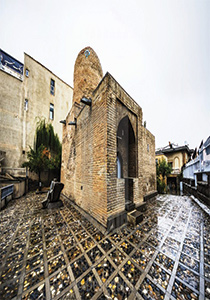Tomb of Esther and Mordechai Hamadan
The traditional location of the graves of Mordechai and Esther, two cousins who played a pivitol role in the Book of Esther (Megillah) is Tomb of Esther and Mordechai in Hamadan. It is one of the most important holy sites for the Jewish people and considered as a key factor in composition of the Jewish community in Hamadan, west of Iran. This monument is registered as one of Iran’s cultural heritage relics. According to the Megillah, in the Old Testament, Esther, the wife of Ahasuerus (probably a transcription of Xerxes, the Achaemenid king of Persia) saved the lives of her uncle Mordechai and the entire Jewish community in the Persian Empire from a sinister plot by Haman, one of the king's courtiers.

History
Mordechai and Esther lived during the rule of Ahasuerus, a Persian king who is also identified as Artaxerxes (possibly Artaxerxes II, who lived from 435 or 445 to 358 BCE). According the Book of Esther, during a feast in Shushan, the capital, Ahasuerus asks his wife Vashti to display her beauty to the assembled guests. She refuses, and he subsequently removes her as queen. He then orders that the provinces of the kingdom be combed for beautiful girls to be brought before him, so that he may select one as his new queen. Esther was a peerlessly inspiring young Jewish woman who caught the eye of the Persian King Ahasuerus, became queen and with the assistance of her relative Mordechai, saved Jews throughout the Persian Empire. In the aftermath, Mordechai is promoted and institutes an annual commemoration of the event which becomes the festival of Purim.
It is noteworthy that, Iranian Jews have made a pilgrimage to the Tomb of Esther and Mordechai for centuries, which features intricate wooden sarcophagi and special sections for lighting candles in veneration of its namesakes. Also, Jews around the world celebrate this salvation during Purim by reading the Book of Esther, dressing in costumes and eating delicacies.
Architecture
The monument belongs to the Jewish Queen of the Achaemenid kingdom and her uncle. The current construction is a square building which is made of stones and bricks. It was constructed according to the architecture of Islamic monuments. It is believed that this construction dates back to 7th century of Hijri calendar and this is due to its facade and architectural style. The mausoleum of Esther and Mordecai includes different parts but it is very simple. The entrance door is a short stone gate and you have to bend to enter.
The building is accessed through a shallow iwan containing a low doorway with a massive granite door, which obliges visitors to bow upon entering. Interior walls are covered with Hebrew inscriptions executed in stone or plaster. In the main hall are two wooden coffins; these are attributed to Esther and Mordechai and carved in intricate geometric patterns and Hebrew inscriptions. The tomb was described as consisting of an outer and inner chamber surmounted by a dome about 50 feet high. The dome had been covered with blue tiles, but most of them had fallen away. A few tombs of worthy Jewish individuals were located within the outer chamber.